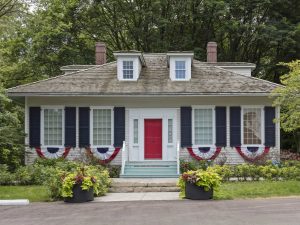Bradley Museum
Hours
| Tuesday | Closed |
| Wednesday | Closed |
| Thursday | 12 p.m. - 4 p.m. |
| Friday | 12 p.m. - 4 p.m. |
| Saturday | 12 p.m. - 4 p.m. |
| Sunday | 12 p.m. - 4 p.m. |
| Monday | Closed |
Admission by donation
Recommended: $5 to $10 per individual or $20 per family
About
The two-acre Bradley Museum site is on the edge of Lake Ontario, nestled in a 70-year old maple grove. It features four heritage buildings:
- The Anchorage, an Ontario Regency style cottage from the early nineteenth century
- The Bradley House, a two-story saltbox-style farmhouse from 1830
- A restored Port Credit log cabin from the mid-1800s
- A barn from the turn of the last century
A variety of themed tours are available, including Bradley Family Settler Experience, Black History in Peel, and Learning about Indigenous Peoples and Truth and Reconciliation.
Tours run on the hour between 12:00 p.m. and 3:00 p.m. Walk-ins are welcome.
History
The buildings at Bradley Museum date back to the 1820s. Learn more about how they were built, who lived in them, and what artifacts are on display today.
This saltbox style farmhouse was built in 1830. The marigold yellow and black house has classic qualities of the period. The builders were Lewis and Elizabeth Bradley, an Empire Loyalist couple from Savannah, Georgia. The couple and their seven children lived here for 20 years.
Lewis Bradley died in 1846, and his wife sold the house. It had several owners until it was purchased by the British American Oil Company (now HF Sunclair Corporation).
The house was slated for demolition in 1959 until local newspaper publisher, Kenneth G. Armstrong, purchased the house. In early 1961, he gave the house to the Township of Toronto Historical Foundation (now Mississauga Heritage Foundation).
In the mid-1960s the house was moved further north on the property. Fundraising and restoration of the house began with a team of volunteers and community activists. In 1967, the Mississauga Heritage Foundation opened the house to the public.
The Anchorage is a Regency-style cottage built in the 1820s near Southdown and Lakeshore Roads. The cottage was donated to the City of Mississauga by the National Sewer Pipe Company and was moved to its current location in 1978.
The cottage was named by its second inhabitant, retired British Navy Commander John Skynner (1762 -1846). The name Anchorage is believed to come from Captain Skynner’s journal where he wrote: ‘I have retired…Here I will rest; this is my anchorage’. Another source has claimed that Stephen Jarvis named the home Anchorage. Jarvis used a sandbar – which was located offshore of his property – to anchor merchant vessels bringing goods from York and Niagara.
A key artifact in the Museums’ collection is The Skynner Cup – a silver decorative urn given to Commander John Skynner by the residents of Malta. Hallmarks on the cup date to 1808. It was made by silversmith firm of James Ede and Alexander Hewat of London. The urn is decorated with a sculpted silver figurine of a woman clutching an albatross in one arm, a laurel wreath extended from the other hand, and surrounded by various nautical items.
The driveshed, barn and outhouse are not original to the Bradley site. They were constructed using old wood from farms in the Peel Region.
The driveshed was constructed on the Bradley site in 1973 using wood found on the Carberry family farm located in Chinguacousy Township. This farm is believed to have been bought by former Toronto Township Reeve Tom Jackson (died 2008) who gave the barn to the Town of Mississauga in 1971. The style of the building is an Ontario vernacular with beam ceilings and post construction.
The barn was reconstructed using old planks of wood from a barn located at the southeast corner of Burnhamthorpe and Erin Mills Parkway. The barn was reconstructed by Bruce Evans Ltd in 1977. The form of the building is classical Ontario vernacular and addresses the farming and rural past of Mississauga.

The cabin, originally built in the mid-19th century, was moved to Port Credit in 1967 as the local Rover Crew’s Centennial Project. It was used by the Rovers and the 4th Port Credit Scouts for many years until it fell into disrepair and was slated for demolition in 2002. A community-led fundraising initiative led to relocation of the Log Cabin to its current site at the Bradley Museum complex.
Gallery
-

The Anchorage, 1900 The Anchorage, 1900 -

Volunteer tending to heritage kitchen garden. Volunteer tending to heritage kitchen garden. -

Pollinator garden Pollinator garden -

Bradley Museum opening day in June 1967 Bradley Museum opening day in June 1967 -

Bradley Log Cabin reconstruction in 2007 Bradley Log Cabin reconstruction in 2007 -

Bradley Log Cabin reconstruction in 2007 Bradley Log Cabin reconstruction in 2007 -

Log Cabin at the original Port Credit site in the early 2000s Log Cabin at the original Port Credit site in the early 2000s -

Bradley House seen from Orr Road Bradley House seen from Orr Road -

Bradley House and heritage garden Bradley House and heritage garden -

Moving of the Bradley house, 1961 Moving of the Bradley house, 1961 -

Bradley House Bradley House -

The Anchorage The Anchorage -

The Anchorage The Anchorage -

The Anchorage in 1978 The Anchorage in 1978
Plan your visit
As historic sites, some of our spaces do have physical barriers. The top floor and bottom floors of Bradley House, the Anchorage, the Log Cabin, and the Barn have stair access only.
Admission is by donation to support exhibition and education experiences. Donations can be made on site using debit or credit. Recommended donations are $5 to $10 per individual or $20 per family.
Facility room and capacity*
- Log cabin
14-20
*Capacity depends on room setup